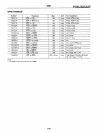
8291
Setting the
"ton"
bit generates the local ton (talk-only)
. message and sets the
8291
to a talk-only mode. This mode
allows the device
to
operate
as
a talker in
an
interface
system without a controller.
Setting
the
"Ion"
bit
generates the local Ion (listen-only)
message and sets the
8291
to
a listen-only mode. This
mode allows the device to operate
as
a listener in
an
interface system
without
a controller.
The mode
of
addressing implemented by the
8291
may be
selected by writing one
of
the following bytes to the
Address Mode Register:
Register Contents
10000000
01000000
11000000
00000001
00000010
00000011
Mode
Enable talk only mode (ton)
Enable listen only mode (Ion)
The
8291
may talk to itself
Mode
1,
(Primary-Primary)
Mode 2 (primary-Secondary)
Mode 3 (primary/APT-Primary/APT)
The Address Status Registercontains information used by
the microprocessor to handle its own addressing. This
information includes status bits that monitor the address
state
of
each talker/listener,
"ton"
and "Ion" flags which
indicate the talk
only
and listen
only
states, and
an
EOI bit
which, when set, signifies that the END message came
with the last data byte.
LPAS and TPAS indicate that the
listener or talker primary address has been received. The
microprocessor can then use these bits when the
secondary address is passed through to determine
whether the
8291
is addressed to talk or listen. The LA
(listener addressed) bit will
be
set when the
8291
is in
LACS (Listener Active State)
or
in LADS (Listener
Addressed State). Similarly, the TA (Talker Addressed bit
will
be
set
to
indicate TACS
or
TAOS, but also
to
indicate
SPAS (Serial Poll Active State). The MJMN bit
is
used to
determine whether the information in the other bits
applies to the Major
or
Minor
talker/listener.
It
is set to "1"
when the
Minor
talker/listener
is
addressed. It should be
noted that
only
one talker/listener may
be
active at any
one time. Thus, the MJMN bit will indicate which, if either,
of
the talker/listeners
is
addressed
or
active.
The Address 0/1 Register is used for specifying the
device's addresses according
to
the format selected in
the Address Mode Register. Five bit addresses may be
loaded into the Address
0 and Address 1 registers by
writing into the Address
0/1
Register. The ARS bit is used
to
select which
of
these registers the other seven bits will
be loaded into. The DT 'and DL brts may be used to disable
the talker
or
lis.tener function at the address Signified by
the other five bits. When
Mode.l
addressing is used and
only
one primary address is desired, both the talker and
the listener should
be
disabled at the
Minor
address.
As an example
of
how
the Address
0/1
Register might be
used, consider
an
example where
t.wo
primarY'addresses
are
.needed in the device. The Major primary address will
be selectable
only
ass
lalker
and the
Minor
primary
address will be selectable
only·
as
a listener. This
configuration
of
the
8291
is fo.rmed by the following
sequence
of
writes
by.
the microprocessor:
Operation
CS RD WR
Data
RSZ-RSO
1
..
Select addressing Mode 1
0
1
0
00000001 100
2.
Load major address
into
0
1
0
001AAAAA
110
Address 0 Register with
listener function disabled.
3.
Load
minor
address into 0 1 0 110BBBBB 110
Address 1 Register with
talker function disabled.
At
this point, the addresses AAAAA and BBBBB are stored
in the Address
0 and Address 1 registers respectively, and
are available to
be
read by the microprocessor. Thus, it
is
not necessary to store any address information elsewhere.
Also, with the information stored in the Address
0 and
Address 1 registers, processor intervention is not required
to
recognize addressing by the controller. Only in Mode3,
where secondary addresses are passed through, must the
processor intervene in the addressing sequence.
Command
Pass
Through Register
I~I~I-I~I~I~I~I~I
COMMAND
PASS
THROUGH (5RI
The Command
Pass
Through Register is used to transfer
undefined 8-bit remote message codes from the
GPIB
to
the
microprocessor. When the CPT feature
is
enabled
(bit
BO
in Auxiliary Register
B),
any message
not
de-
coded by the
8291
becomes an undefined command.
When Mode 3 addressing
is
used secondary addresses
are also passed through the CPT Register.
In
either
case, the
8291
will
holdoff
the handshake
until
the
microprocessor
reads
this
register and issues the
VSCMD auxiliary command.
The CPT and APT interrupts flag the availability
of
undefined commands and secondary addresses in the
CPT Register. The details
of
these interrupts are explained
in the section on
Interrupt Registers.
An added feature
of
the
8291
is its
ability
to handle
undefined secondary commands following undefined
primaries: Thus, the number
of
available commands
for
future IEEE 488 definition is increased; one undefined
primary command followed by a sequence
of
as many as
32 secondary commands can be processed. The IEEE-488
Standard does. not permit users to define their own
commands, but upgrades
of
the standard are thus
.provided for.
9-92
The recommended use
o.f
the
8291
's undefined command
capabilities is
for
a controller-configured Parallel Poll.
The PPC message is
an
undefined primary command
typically followed by
PPE,
an undefined secondary
command. For details on this procedure, refer to the
section on
Parallel Poll Protocol. .


















